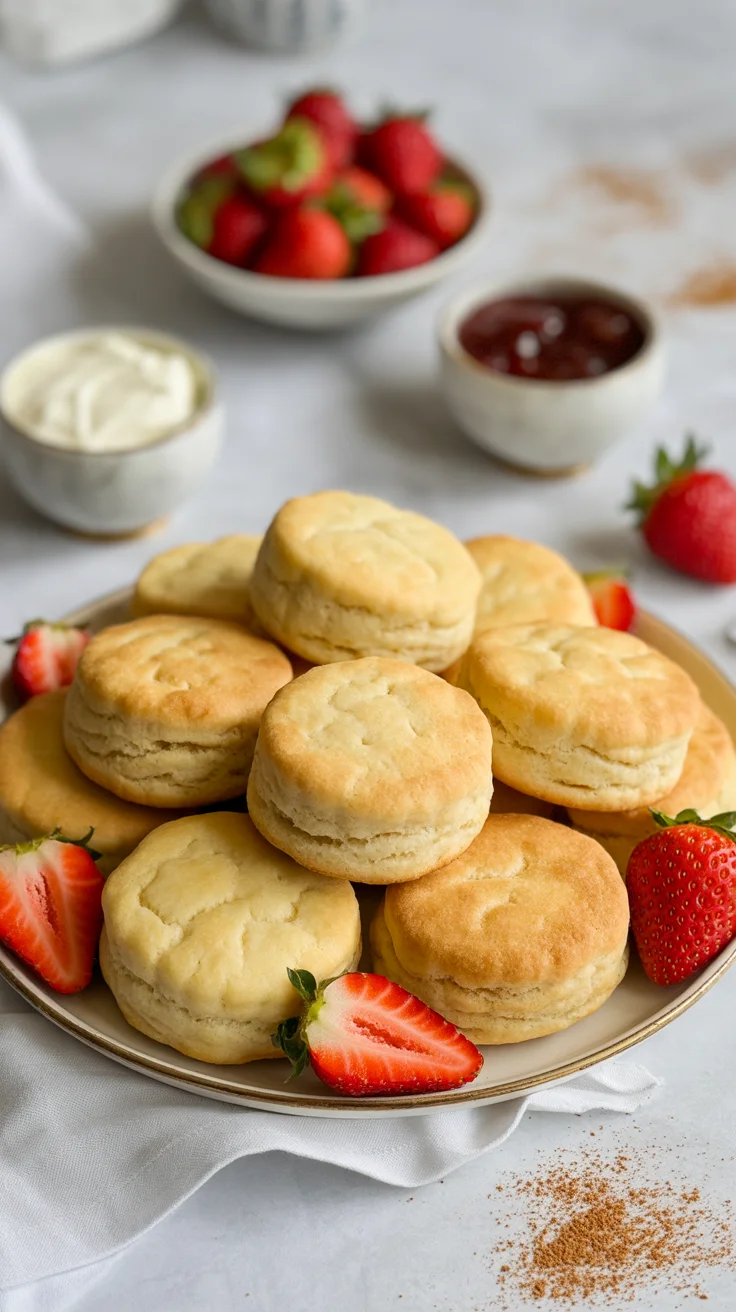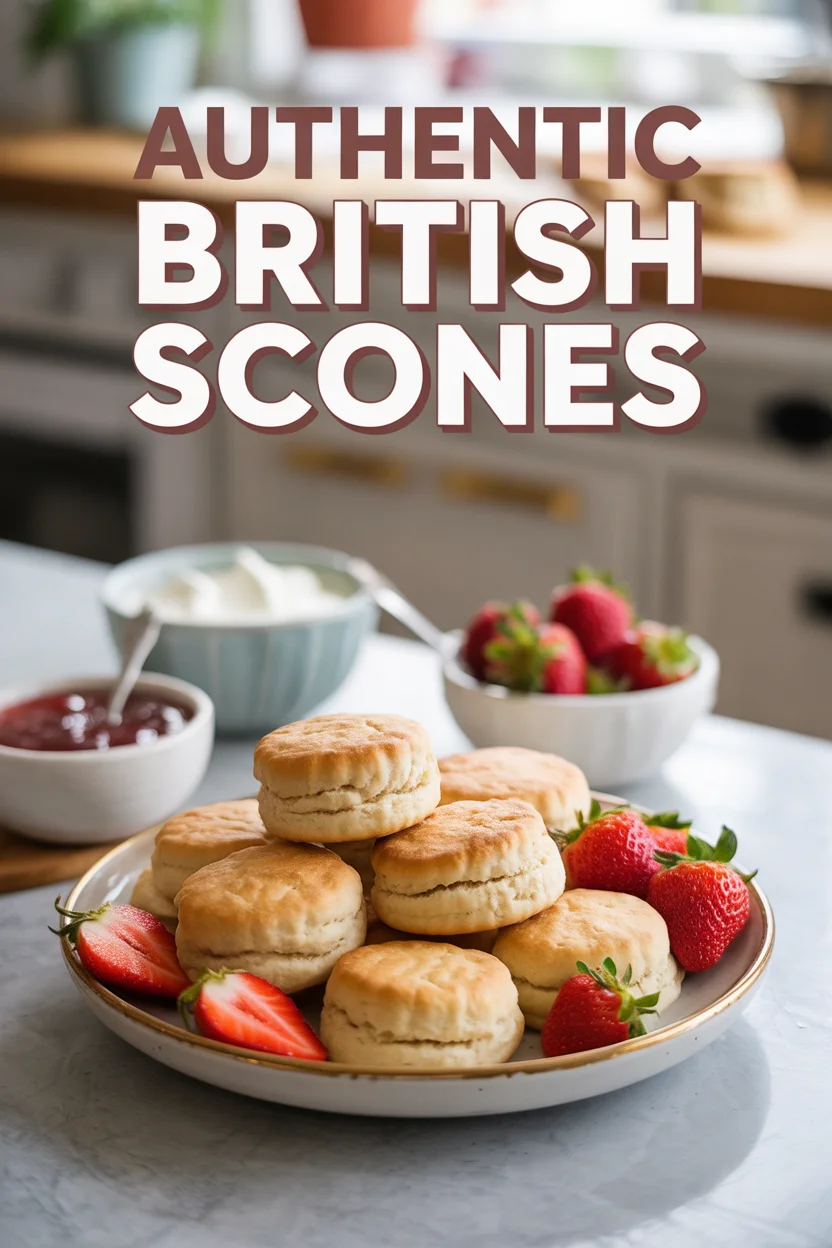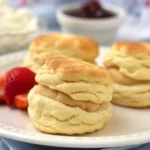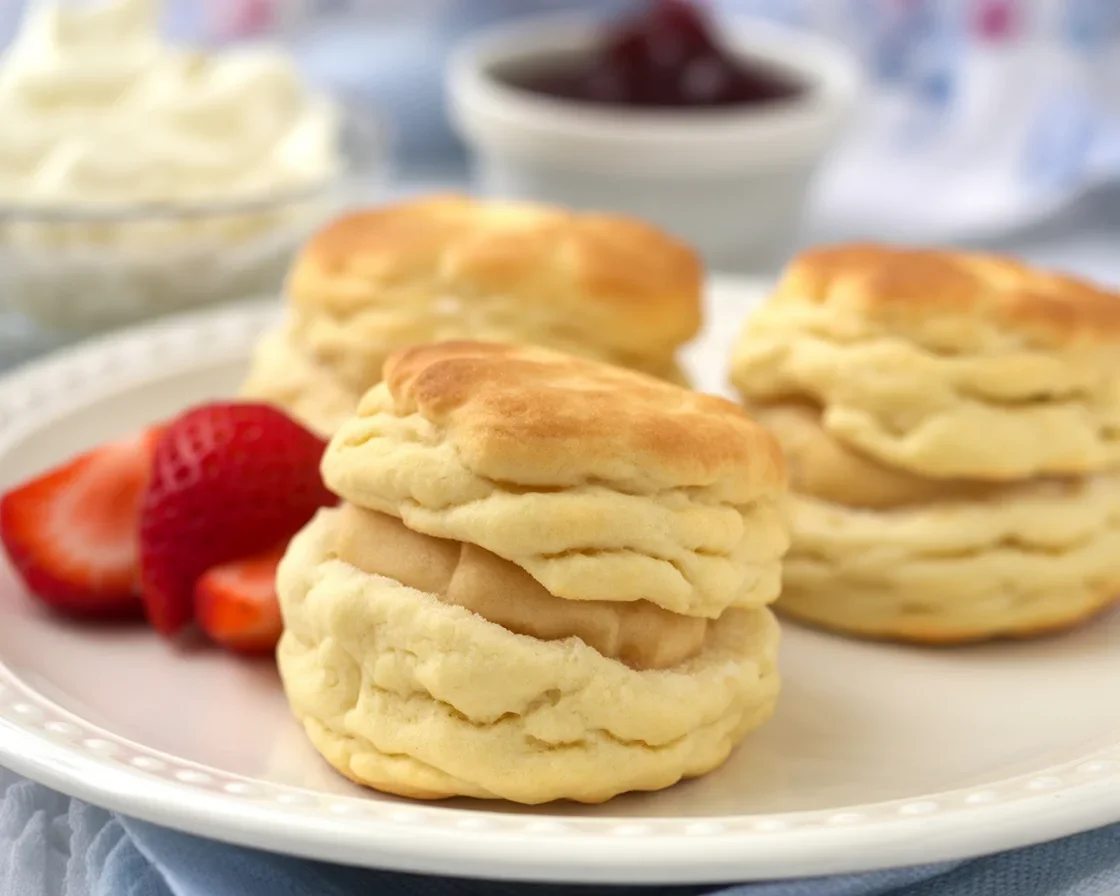Authentic British Scones just don’t taste the same outside the UK, do they? You buy those supermarket packs, and they’re okay, but… sort of dry, right? Maybe you’ve tried making them at home, but they came out rock solid or crumbly. Been there (too many times).

If you want to bake the real deal—light, just a tad sweet, the sort of thing you’d serve at “proper” afternoon tea—stick with me. I’ve got an easy method, a few unexpected tricks, and a little bit of backstory.
Oh, and if you ever wondered about clotted cream (what even is that?), we’ll get there. For more tips and other classic British treats, check out my favorite tea-time recipes.
What is a scone?
Okay, picture this: You’re at your mate’s house, tea’s brewing, and someone cracks open a tin of scones. But what is that thing exactly? Not a muffin, not a bun—it’s its own weird, wonderful baked good.
Authentic British scones are a staple at any English tea, fluffy and soft, not sugary like cupcakes. Traditionally, they’re sliced and smeared with clotted cream and jam (honestly, nothing else comes close). The flavor’s subtle—just enough sweetness to taste, with a crust that’s barely brown.
People argue about how to say it, too. Is it “skon,” as in “gone”? Or “skoan,” like “stone”? Brits even fight about the order of toppings. (I’m team jam-first, in case you wondered.) Either way, you bite in and suddenly understand what all the fuss in Downton Abbey was about. Scones aren’t fancy or fussy—they’re cosy, if you ask me.
.Authentic British Scones
Is a scone a biscuit?
Short answer? Not really. But I get why folks confuse them. They look alike—round, baked, golden on top. But authentic British scones have a totally different vibe from American biscuits. A biscuit in the States is flaky, savory, falls apart on your plate with gravy poured over it (which is lovely, just not what you want at tea).
Scones, though? They’re a bit denser, definitely not salty, and you’d never drown them in sausage gravy. That’s a crime in some circles. The texture is softer, somewhere between a cookie and bread. The real sign you’ve nailed the British version is the ‘split’—the way it naturally opens when pulled apart. Not dry, not greasy—just right.
“I always thought a scone was just a sweet biscuit, but the texture is like nothing else. My first batch came out flat, but following this recipe? They tasted just like the ones from my favorite London café!”
— Maya L.
Authentic British Scones
What is the difference between an American scone and a British scone?
Now this gets folks ruffled. Walk into a coffee shop in the US, grab a “scone,” and it’s a wedge, lots of sugar, add-ins like chocolate chips or blueberries—sometimes even glazed. Usually, it’s crumbly and pretty rich. But authentic British scones? Totally different game.
First off, they’re not overly sweet. British scones are round, often cut with a cutter (like cookies, but thicker). The dough is simpler, usually just cream, flour, butter, and a little sugar. No massive add-ins or heavy icing—fruit scones might have currants, but that’s about as wild as it gets.
Plus, American scones often pack in loads of butter, resulting in that crisp, crunchy bite. Brits want a tender, almost spongy inside with a soft crust. Serve ’em warm, butter melting slightly, with classic strawberry jam. I know, sounds like heaven—and it is.
Authentic British Scones
Ingredients and substitutions
Alright, non-Brits, don’t panic if you can’t get “self-raising flour” or “clotted cream.” Here’s what you need for authentic British scones, plus a few swap-outs if you’re stuck:
- Plain flour (all-purpose is fine, but self-raising will give you a softer scone—just add a spoonful of baking powder if using all-purpose)
- Baking powder (if your flour isn’t self-raising)
- Cold, unsalted butter (don’t go warm, or your scones won’t rise. I promise)
- White sugar (caster sugar is traditional, but granulated works)
- Milk (full-fat makes a richer scone)
- Eggs (for brushing)
- Salt (just a pinch, don’t skip it)
Want to mix it up? Chuck in a handful of currants or raisins for “fruit scones,” or go wild with a tiny bit of grated cheese for “savory” ones (my gran would judge me for this, but it’s delicious).
Serving Suggestions? Here are my scone musts:
- Dollop of clotted cream (or thick whipped cream)
- Tart, good-quality strawberry or raspberry jam
- If you fancy, a pat of butter right out of the oven
- Cup of strong black tea (milk, no sugar for me)
Authentic British Scones
How to make English scones
This next bit is key: Don’t overthink it. My first try, I patted the dough like pizza—tough as boots. Since then, here’s what I’ve learned:
Preheat your oven hot—about 220°C (428F). The high heat makes them puff fast. Grab a big bowl, toss in your flour, sugar, salt, and baking powder. Rub in the butter with your fingertips until it looks like breadcrumbs (feels a bit messy, but so satisfying—kids love this part).
Next, pour in your milk. Stir with a knife or fork, don’t use your hands yet! If you overmix, the scones turn dense, not fluffy. Once it just comes together (it’s going to look a bit rough), tip it onto a floured board, gently pat it down till about 2 cm (barely an inch) thick. Press a round cutter straight down—don’t twist, that hurts the rise.
Lay them on a tray, brush with beaten egg for a shiny top, and bake about 10–13 minutes till pale gold. Breathe in. Wait a minute or two, then split and eat—preferably with friends, lots of laughing, and sticky fingers.

Conclusion
There you go—my not-so-secret method for authentic British scones. No more bland, rock-hard imposters. Afternoons get cozier, and if you set out a plate, they’ll disappear instantly (even my teenager can’t resist). Feel free to adjust and experiment—a true scone lover changes the recipe until it’s perfect for their kitchen.
If you want some extra background and tips, you’ll learn a lot from digging into the great post over at Authentic British Scones • Curious Cuisiniere. Happy baking—and save some for me, all right?
Authentic British Scones
Print
Authentic British Scones
- Total Time: 28
- Yield: 8 servings 1x
- Diet: Vegetarian
Description
Deliciously fluffy and subtly sweet, these authentic British scones are perfect for afternoon tea, served with clotted cream and jam.
Ingredients
- 2 cups plain flour (or self-raising flour)
- 1 tablespoon baking powder (if using plain flour)
- 1/2 cup cold, unsalted butter
- 1/4 cup white sugar
- 3/4 cup full-fat milk
- 1 egg (for brushing)
- Pinch of salt
- Optional: Handful of currants or raisins
- Optional: Grated cheese for savory scones
Instructions
- Preheat your oven to 220°C (428°F).
- In a large bowl, combine flour, sugar, salt, and baking powder.
- Rub in the cold butter with your fingertips until the mixture resembles breadcrumbs.
- Pour in the milk and stir with a knife until just combined.
- Transfer the dough to a floured surface, pat it down to about 2 cm thick.
- Use a round cutter to cut out scones, pressing straight down without twisting.
- Place on a baking tray and brush the tops with beaten egg.
- Bake for 10–13 minutes until pale gold.
- Let cool for a few minutes, then split and serve with clotted cream and jam.
Notes
Serve warm for the best flavor and texture. Experiment with adding currants or cheese for variation.
- Prep Time: 15
- Cook Time: 13
- Category: Dessert
- Method: Baking
- Cuisine: British
Nutrition
- Serving Size: 1 scone
- Calories: 230
- Sugar: 6g
- Sodium: 150mg
- Fat: 10g
- Saturated Fat: 6g
- Unsaturated Fat: 3g
- Trans Fat: 0g
- Carbohydrates: 30g
- Fiber: 1g
- Protein: 4g
- Cholesterol: 35mg

